There were three of them then, sharing a ninth-floor loft in “a nightmare of a neighborhood” three blocks from CBGB’s that went for $289 per month.
Outside, the sidewalk hookers pulled in fares for five bucks a pop over-watched by a manager who carried a baseball bat beneath his knee-length fur coat, should anything go awry.
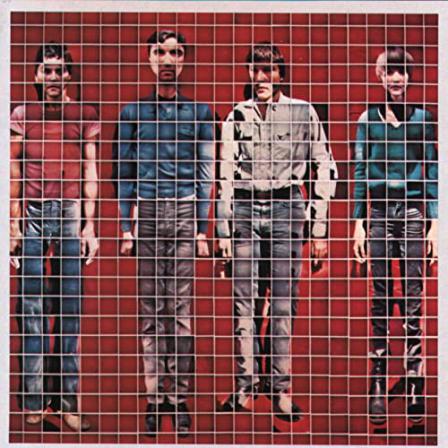
“More Songs About Buildings and Food,” Talking Heads second album. The cover image is comprised of hundreds of Polaroids taken by David Byrne and Tina Weymouth atop the roof of Weymouth and Frantz’ loft in Queens, N.Y.
Inside, beneath the loft’s 12-foot-tall ceilings, Chris Frantz – with his black-and-gold sparkle Slingerland drum kit, David Byrne – with his two guitars, and Tina Weymouth – cradling a 1963 Fender Precision bass guitar nearly as large as she was, would return from their respective day jobs and gather together nightly with instruments at hand. A single telephone sat on a table in the corner. The adjacent wall was marked up with the numerical scratches of frequently used phone numbers. It was during these rehearsals that many of the songs later celebrated the world-over were born. The band of three needed a name.
The Vogue Dots?
The Billionaires?
How about The Tunnel Tones?
The three artists tried out the names visually by fixing stick-on letters on to Frantz’ bass drum head. None looked right ‘til a friend discovered an unusual phrase while leafing through the glossary of television cameraman terms in a copy of the TV guide. What about Talking Heads?
They slapped silver characters of the alphabet upon some T-shits and took it for a ride. “One guy asked, ‘Are you guys in a band?’ Another said, ‘Oh man, that’s a terrible name!’” Frantz recalled, of a memorable walk with through Washington Square Park where both he and Weymouth each wore their lettered shirts. “Today that T-shirt of Tina’s is on display in the Rock and Roll Hall of Fame.”
Frantz details the journey that led the band from there to here in his just-published biography, “Remain In Love: Talking Heads: Tom Tom Club: Tina.”
“I’ve been thinking about a book for a good long time,” Frantz says on a quiet, rainy Wednesday in July, his peaceful recollections momentarily interrupted by the sounds of the two beagles - Poppy and Kiki – excitedly announcing the arrival of the UPS man coming up the driveway. “I had a strong desire to give AN inside story; I’m sure there are four inside stories to the Talking Heads – but I wanted to give mine, because there were a few books written that were just bullshit. They just made things up. I know what really happened, so I wanted to convey that. I think people can get a good idea of what it was like to be in Talking Heads, and Tom Tom Club.”
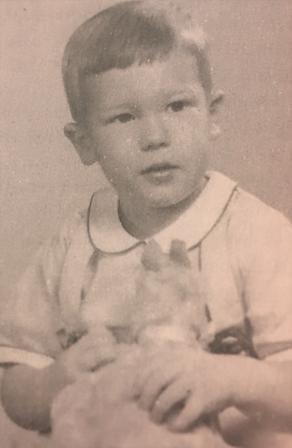
Young Chris Frantz. From the Frantz Collection.
With “Remain In Love,” Frantz delivers a 56-chapter chronology that begins where he did - in a Kentucky Army Hospital in 1951, the son of an Army officer, and of a mom whom he calls a southern belle. Frustrating attempts with a trumpet while playing in his school band earned young Chris a chance of a different opportunity when he was given a pair of sticks and a seat behind the drums. While watching Ed Sullivan introduce the Beatles on TV one Sunday evening in 1964, he had an epiphany. “The advent of the Beatles and the British Invasion that followed was, and still is, one of the most culturally important events of my lifetime,” he writes. Another came seven years later at the Rhode Island School of Design.
“It was at the beginning of the school year in September of ’71,” he writes. “Suddenly, as in a scene from a Truffault movie, I saw a girl pedaling down Benefit Street in our direction on an old yellow three-speed bicycle. She wore a blue-and-white-striped French sailor’s shirt and very short shorts…” The girl was a schoolmate and the next day in the Figure Painting class they shared, he went over and introduced himself. Her name was Tina. The private art and design school in Providence, Rhode Island also provided the grounds where Frantz and Weymouth would soon meet David Byrne.
“His hair was bleached blond, almost white, which contrasted with his black eyebrows and the profuse black hair on his arms. He wore black leather trousers that he said he had made himself,” Frantz recalls. One day, Byrne came to the painting studio that Frantz and Weymouth – now a couple – were sharing. He said he had been writing a song in a style somewhat like Alice Cooper and hoped the pair could help him with it.
Byrne’s verse began: “I can’t seem to face up to the facts/ I’m tense and nervous and I can’t relax…” Weymouth, who spoke French, added the song’s bridge, and Frantz scripted additional verses. “Continuing with the psychotic theme as we were brainstorming, I shouted, ‘We are vain and we are blind!’ and Tina said, ‘Yeah, yeah, and I hate people when they’re not polite.’ David wrote it all down in his little spiral notebook,” Frantz writes. “It was our first songwriting experience together and it was proof enough for me that we should do more of this in the future.”
Following graduation at RISD, all three moved to New York. Frantz’ pre-conceived thoughts of his TV-inspired viewings of the “playful skid-row hangout” of the Bowery Boys were doused with the jarring reality of a broken city. “When I first saw the Bowery with my own eyes in September of 1974, it was not the least bit playful or funny,” he writes, recounting the vulgar collaboration of cheap wine, lewd acts and flophouses.
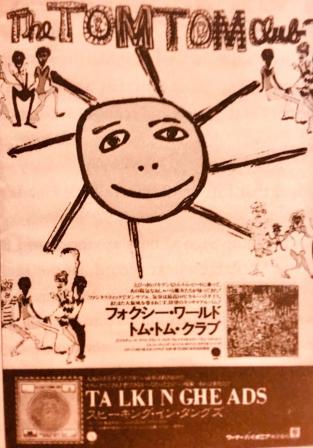
Tom Tom Club / Talking Heads, from the book “Remain In Love.”
“I had been dreaming of a place where my as-yet formed band could play. I imagined that there could be a place as important to our band as the Cavern Club and the Star Club had been to the Beatles,” Frantz notes. The search led him to CBGB’s where a guy playing pool inside a silver sharkskin suit told him to come back during the weekend and check out a band who called themselves The Ramones. He did. “Their songs were hard, loud, and very fast. I had never seen anything like it. As I left CBGB that weekend, the pretty girl at the door told me that next week a cool band called Television was playing. I told her I’d be there.”
By May 1975, the three art students had sufficiently put together enough songs for an act. Their first gig was at CBGB’s, opening for The Ramones. Frantz wore a white Brooks Brothers shirt, Weymouth red sneakers, and Byrne a pair of gray suede Hush Puppy loafers. About 20 people showed up to watch.
“From my first visit, CBGB held a great importance in my life,” he says, throughout the book offering thumbnail sketches of the bands and the personalities – Patti Smith to Television, Blondie, Wayne County, and Richard Hell to The Ramones - he witnessed.
“Tina and I and David were very fortunate to be in New York then,” Frantz says. “We were just in the right place at the right time. Had we been in, you know Chicago, who knows if anyone would have heard of us. There was CBGB’s and we could play there. It was like magic, it just snowballed.”
The depth in the detail of his telling is enlightening and had to have been born out of a precise documenting at that time.
“I’m still kicking myself for not keeping a journal at the time because there were extraordinary events going on around me. I’m also mad I never had a camera, but thanks to Tina I did have a date book that she kept,” Frantz says, when asked whether he kept a diary. “Tina had one of those date books that she had bought at the Metropolitan Museum of Art. The year 1977 has King Tut on the cover! She was our road manager then and kept track of dates, the name of the venue we played, the name of the hotel where we stayed in, the amount of tickets sold and whether or not we felt it was a good show and how many encores we got. Sometimes she would say: fantastic show, everything was great. At other times she wrote: Never come back to this place again! So, I had that to refer to and it helped trigger memories of various cities and towns.”
There are humorous moments - walking into Paul Pines’ Tin Palace and coming upon a “high as a kite” Mick Jagger, head topped by a huge quilted pimp-style newsboy hat, singing along – with inappropriately altered lyrics – to the jukebox playing of Roberta Flack’s “Killing Me Softly.” Another time he was approached at CBGB’s by an inquisitive Johnny Thunders inquiring whether Talking Heads was a feminist band. At the same venue Frantz recalled jumping over the tables when spotting Lou Reed, to ask for an autograph.
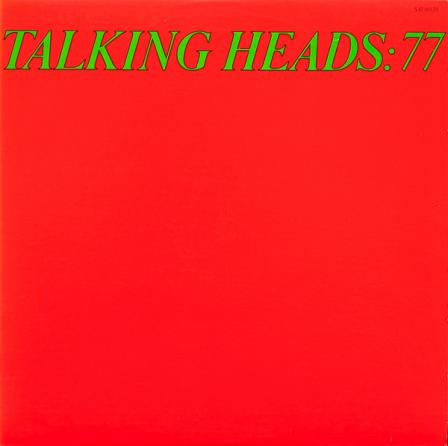
“Talking Heads ’77.” The band’s debut album.
“Yeah, I was a big fan of his. I was thinking: I’ve got to get his autograph before he leaves,” Frantz says with a chuckle. “I don’t usually do that, but I guess I’d had a few beers and thought: ‘Oh my God, there’s Lou Reed!”
There were also warning signs that began to emerge, specific to David Byrne and his “seemingly continual need to aggrandize himself at the expense of his collaborators. Tina has said that he seems incapable of returning friendship. We learned this from experience,” Frantz writes. “David was different. He got into music to get out of himself. When you played music with David you came to realize that his eccentricities were not an act.”
Mostly, however, there are the documentations of some splendid times as the Talking Heads threesome added Jerry Harrison and became four, and the band’s ever-expanding musical breadth and popularity through the ‘80s, Frantz and Weymouth’s relationship, the birth of their two sons and the emergence of their own band, Tom Tom Club.
“I still have the image burned in my memory of Tina surrounded by the bass players Dee Dee Ramone, Captain Sensible, and Sid Vicious,” he says. His perch atop the riser behind his Mojave Red Rogers kit also offered a view like no other. “The air is warm and damp and thick with cigarette smoke,” he writes, the crowd “swaying, pulsating, and screaming like one huge wild beast. Tina, looking exceptionally fine in a dress she had made herself, a strapless white sheath with a slit on the side all the way up-to-the-top-of-here thigh, gave her shiny blonde hair a toss and played boom, boom, boom, boom, boom, boom, boom-boom-boom. Her familiar introduction to ‘Psycho Killer’ set off a roar from the audience.”
“In 1991, David sneaked out of Talking Heads,” Franz writes in the book’s concluding chapter. Ten years later they would reunite for a brief performance at their Rock and Roll Hall of Fame induction ceremony. Byrne disappeared before the first cork of celebratory champagne was popped at the post-show reception.
He was asked what surprised him most, or what new thing he learned while collecting and committing his memories to paper.
“Writing the book, I think I developed more empathy for the job David Byrne had to do and also for Tina and the gig she had to do. I mean I was loving every minute, but I can see now that maybe Tina and David were not loving every minute. There were certainly high points but there were also struggles, so I’m more sympathetic than I was then,” Frantz says.
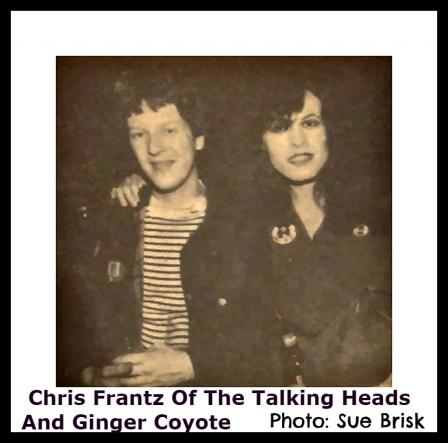
“After I sat down and wrote the outline – and I’m not a person who loves doing outlines – I thought: Damn. Look what we did. We worked our asses off. It’s really a challenge the amount of hours you put in, but there was never any doubt in my mind that we could do it, that we could succeed. We have an amazing chemistry, and this is going to work!” he says. “And we actually succeeded more quickly than I expected. I was willing to give ourselves five years – they used to say, ‘Give yourself five years,’ and I think it was after three years we already had a record album and were touring the world.”
Currently, Frantz’ time is preoccupied with promoting the book. After 42 years of marriage, Frantz says he Weymouth and continues to have a wonderfully romantic life together. Their son Robin works in music production, and son Marshall Egan is a painter and sculptor. Looking ahead, Frantz says he thinks he’s got another book in him – “maybe a travel book,” and adds that Weymouth is in the early days of working on her own book. “You know we’re of a certain age now, but we still have the desire to make art. We have a very nice studio here and we were thinking of just going into the studio with a drum machine and some synthesizers and doing something electronic. Just the two of us. That’s something we’ve never done before, and we’d just see what happens. We were very encouraged by a thing we did on YouTube a few years ago called ‘Incognito.’ “
Inevitably, the question comes up regarding whether he can foresee a time working again with David Byrne.
“You know I’m always ready to work with people in Talking Heads. It’s an amazing band and it’s been so long now – but I believe we’re still the same people.” He pauses for a beat. “We can do it again, but you know for one reason or another David has for a long time just refused to even consider that, so… it’s a moot point.”
“Remain In Love: Talking Heads: Tom Tom Club: Tina,” by Chris Frantz, St. Martin’s Press. $29.99 hardcover, with photographs.



